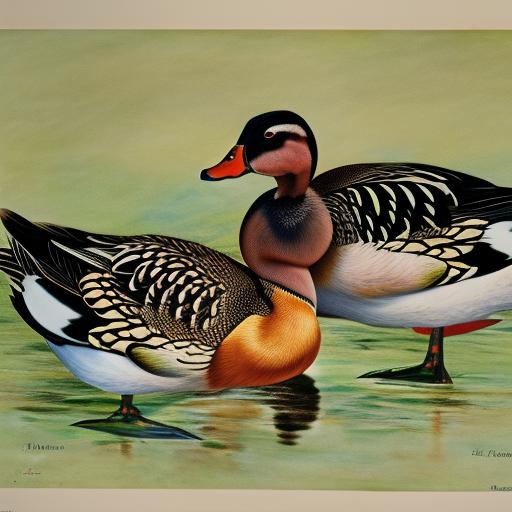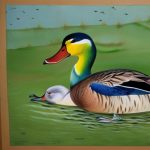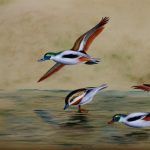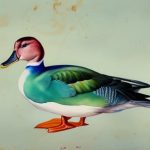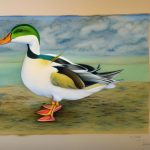Wild ducks are a diverse group of waterfowl that are found in a variety of habitats around the world. They are known for their beautiful plumage, distinctive calls, and impressive migratory patterns. Wild ducks play a crucial role in the ecosystem as they help control insect populations, disperse seeds, and provide food for predators. There are many different species of wild ducks, each with its own unique characteristics and behaviors. In this article, we will explore some of the most well-known species of wild ducks, including the mallard duck, wood duck, northern pintail, gadwall, American wigeon, and canvasback.
Key Takeaways
- Wild ducks are a diverse group of waterfowl that includes several different species, each with its own unique characteristics and behaviors.
- Mallard ducks are the most common and widely recognized wild duck species, known for their distinctive green heads and quacking calls.
- Wood ducks are known for their stunningly colorful plumage and are commonly found in wooded swamps and marshes.
- Northern pintails are elegant and slender ducks with long, pointed tails, known for their graceful flight and striking appearance.
- Gadwalls are often overlooked but are distinguished by their subtle yet beautiful plumage and are commonly found in shallow wetlands and marshes.
- American wigeons are known for their distinctive “bald” white foreheads and are often found grazing on grasses in wetland habitats.
- Canvasbacks are large diving ducks with striking red heads and are known for their impressive diving and underwater foraging abilities.
Mallard Duck
The mallard duck is perhaps the most recognizable and widespread species of wild duck. With its striking iridescent green head, bright yellow bill, and mottled brown plumage, the mallard is a familiar sight in ponds, lakes, and rivers across North America and Eurasia. Mallards are highly adaptable and can be found in a wide range of habitats, from urban parks to remote wetlands. They are also known for their distinctive quacking call and their impressive courtship displays during the breeding season. Mallards are omnivorous and feed on a variety of plant matter, insects, and small fish. They are also an important game bird and are hunted for sport and food in many parts of the world.
The mallard duck is a dabbling duck, which means that it feeds by tipping its head down into the water to reach aquatic plants and invertebrates. It is also a highly migratory species, with populations in North America traveling south for the winter and returning north to breed in the spring. Mallards are also known for their hybridization with other duck species, leading to a wide range of plumage variations and genetic diversity within the species. Overall, the mallard duck is a fascinating and iconic species that has captured the imagination of birdwatchers and nature enthusiasts around the world.
Wood Duck
The wood duck is a stunningly beautiful species of wild duck that is found in North America. With its iridescent green and purple head, striking white throat, and intricate patterns on its body, the wood duck is often considered one of the most visually appealing waterfowl species. Wood ducks are known for their preference for wooded wetlands and swamps, where they nest in tree cavities or nest boxes. They are also highly sought after by birdwatchers and photographers due to their vibrant plumage and shy nature.
Wood ducks are unique among wild ducks in that they have sharp claws on their feet that allow them to perch and nest in trees. They are also one of the few duck species that have been known to lay their eggs in the nests of other wood ducks, a behavior known as brood parasitism. Wood ducks feed on a variety of plant matter, seeds, insects, and small fish, and they are often seen foraging in shallow water or along the edges of wooded areas. Overall, the wood duck is a fascinating and beautiful species that is highly valued for its aesthetic appeal and ecological importance.
Northern Pintail
The northern pintail is a graceful and elegant species of wild duck that is found in North America, Europe, Asia, and parts of Africa. With its long neck, slender body, and distinctive pointed tail feathers, the northern pintail is easily recognizable in flight or on the water. Pintails are known for their swift and agile flying abilities, as well as their striking plumage, which includes a chocolate-brown head, white breast, and gray body with black markings. They are also known for their high-pitched whistling calls, which can often be heard during their migratory flights.
Northern pintails are dabbling ducks that feed on a variety of plant matter, seeds, and invertebrates. They are often seen foraging in shallow water or along the edges of marshes and wetlands. Pintails are also highly migratory and can travel long distances during their annual migrations between their breeding and wintering grounds. They are also known for their elaborate courtship displays, which involve the male pintails performing aerial acrobatics and vocalizations to attract females. Overall, the northern pintail is a striking and charismatic species that is highly valued by birdwatchers and conservationists alike.
Gadwall
The gadwall is a medium-sized species of wild duck that is found in North America, Europe, Asia, and parts of Africa. With its mottled gray-brown plumage, black rear end, and distinctive white wing patches, the gadwall is easily recognizable in flight or on the water. Gadwalls are known for their quiet nature and subtle beauty, often blending into their surroundings with their understated plumage. They are also known for their distinctive vocalizations, which include soft quacking calls and whistles.
Gadwalls are dabbling ducks that feed on a variety of plant matter, seeds, and invertebrates. They are often seen foraging in shallow water or along the edges of marshes and wetlands. Gadwalls are also highly migratory and can travel long distances during their annual migrations between their breeding and wintering grounds. They are also known for their cooperative breeding behavior, with pairs often forming long-term bonds and working together to raise their young. Overall, the gadwall is a subtle yet captivating species that is highly valued by birdwatchers and nature enthusiasts for its understated beauty and ecological importance.
American Wigeon
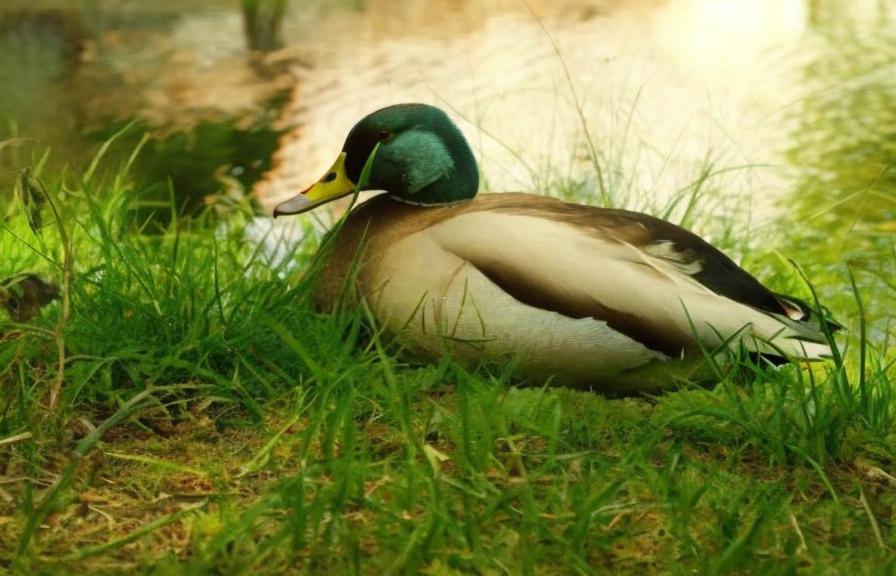
The American wigeon is a medium-sized species of wild duck that is found in North America. With its distinctive white forehead patch, iridescent green eye patch, and chestnut-colored body with black and white markings, the American wigeon is easily recognizable in flight or on the water. Wigeons are known for their vocalizations, which include soft whistling calls and nasal whinnies that can often be heard during their migratory flights.
American wigeons are dabbling ducks that feed on a variety of plant matter, seeds, and invertebrates. They are often seen foraging in shallow water or along the edges of marshes and wetlands. Wigeons are also highly migratory and can travel long distances during their annual migrations between their breeding and wintering grounds. They are also known for their cooperative feeding behavior, often forming large flocks with other waterfowl species to forage together in open water or agricultural fields. Overall, the American wigeon is a striking and sociable species that is highly valued by birdwatchers and conservationists for its beauty and ecological importance.
Canvasback
The canvasback is a large species of wild duck that is found in North America. With its distinctive sloping profile, long black neck, bright red eyes, and intricate black-and-white plumage patterns, the canvasback is easily recognizable in flight or on the water. Canvasbacks are known for their preference for open water habitats such as large lakes, rivers, and coastal estuaries where they can dive for aquatic plants and invertebrates.
Canvasbacks are diving ducks that feed primarily on the roots and tubers of aquatic plants such as wild celery and sago pondweed. They are also known to feed on small crustaceans and mollusks found in shallow water habitats. Canvasbacks are highly migratory and can travel long distances during their annual migrations between their breeding grounds in North America and their wintering grounds in the southern United States and Mexico. They are also known for their distinctive nasal calls that can often be heard during their migratory flights. Overall, the canvasback is a striking and specialized species that is highly valued by birdwatchers and conservationists for its unique beauty and ecological importance.
In conclusion, wild ducks are a diverse group of waterfowl that play a crucial role in ecosystems around the world. From the iconic mallard to the stunning wood duck to the elegant northern pintail to the subtle gadwall to the sociable American wigeon to the specialized canvasback, each species has its own unique characteristics and behaviors that make them fascinating subjects for birdwatchers and nature enthusiasts alike. By learning more about these remarkable birds, we can gain a greater appreciation for the beauty and complexity of the natural world around us.
Sure, here’s the paragraph with the related article included as an tag:
If you’re interested in learning more about breeds of wild ducks, you’ll love our recent article on PoultryWizard.com. We’ve compiled a comprehensive guide to different types of wild ducks, complete with stunning pictures that showcase their unique features and colors. Whether you’re a wildlife enthusiast or simply appreciate the beauty of these magnificent creatures, this article is a must-read. And if you’re also into raising chickens, be sure to check out PoultryWizard’s article on chicken coop interior ideas, chicken coop Muskegon, and chicken coop 10 for some great tips and inspiration.
FAQs
What are wild ducks?
Wild ducks are species of ducks that are not domesticated and live in their natural habitats such as wetlands, marshes, and lakes. They are known for their migratory behavior and colorful plumage.
How many breeds of wild ducks are there?
There are over 120 different species of wild ducks, each with its own unique characteristics and behaviors.
What are some common breeds of wild ducks?
Some common breeds of wild ducks include the Mallard, Wood Duck, Northern Pintail, Gadwall, and Teal. Each of these breeds has distinct physical features and behaviors.
What do wild ducks eat?
Wild ducks are omnivorous and feed on a variety of foods including aquatic plants, insects, small fish, and crustaceans. They may also forage for grains and seeds on land.
Where can wild ducks be found?
Wild ducks can be found in a variety of habitats around the world, including North America, Europe, Asia, and Africa. They prefer wetland areas with access to water for feeding and nesting.
Are wild ducks protected species?
Many species of wild ducks are protected under conservation laws due to habitat loss and hunting pressures. It is important to check local regulations before interacting with or hunting wild ducks.
What is the lifespan of wild ducks?
The lifespan of wild ducks varies by species, but on average, they can live for 2-5 years in the wild. However, some species can live up to 10 years or more in favorable conditions.
Meet Walter, the feathered-friend fanatic of Florida! Nestled in the sunshine state, Walter struts through life with his feathered companions, clucking his way to happiness. With a coop that’s fancier than a five-star hotel, he’s the Don Juan of the chicken world. When he’s not teaching his hens to do the cha-cha, you’ll find him in a heated debate with his prized rooster, Sir Clucks-a-Lot. Walter’s poultry passion is no yolk; he’s the sunny-side-up guy you never knew you needed in your flock of friends!

